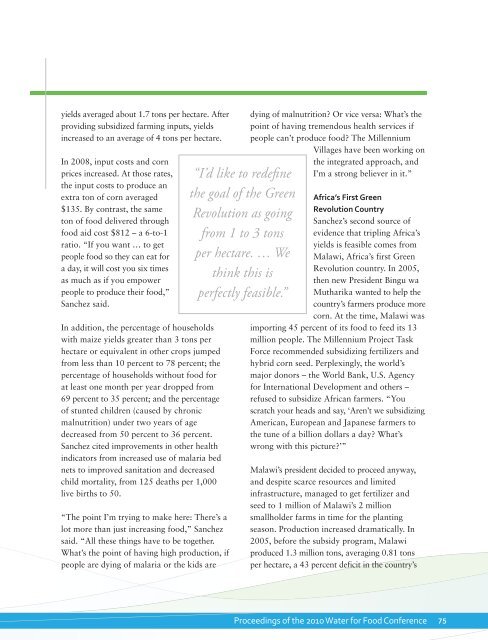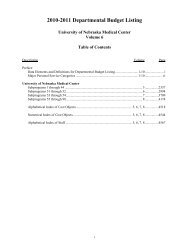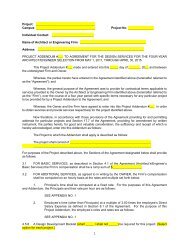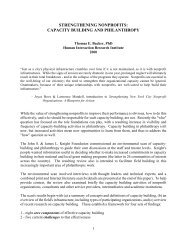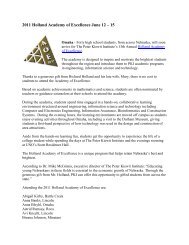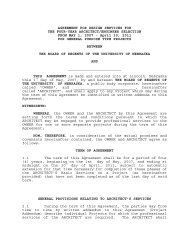Full Version - Water for Food Institute - University of Nebraska
Full Version - Water for Food Institute - University of Nebraska
Full Version - Water for Food Institute - University of Nebraska
Create successful ePaper yourself
Turn your PDF publications into a flip-book with our unique Google optimized e-Paper software.
yields averaged about 1.7 tons per hectare. After<br />
providing subsidized farming inputs, yields<br />
increased to an average <strong>of</strong> 4 tons per hectare.<br />
In 2008, input costs and corn<br />
prices increased. At those rates,<br />
the input costs to produce an<br />
extra ton <strong>of</strong> corn averaged<br />
$135. By contrast, the same<br />
ton <strong>of</strong> food delivered through<br />
food aid cost $812 – a 6-to-1<br />
ratio. “If you want … to get<br />
people food so they can eat <strong>for</strong><br />
a day, it will cost you six times<br />
as much as if you empower<br />
people to produce their food,”<br />
Sanchez said.<br />
In addition, the percentage <strong>of</strong> households<br />
with maize yields greater than 3 tons per<br />
hectare or equivalent in other crops jumped<br />
from less than 10 percent to 78 percent; the<br />
percentage <strong>of</strong> households without food <strong>for</strong><br />
at least one month per year dropped from<br />
69 percent to 35 percent; and the percentage<br />
<strong>of</strong> stunted children (caused by chronic<br />
malnutrition) under two years <strong>of</strong> age<br />
decreased from 50 percent to 36 percent.<br />
Sanchez cited improvements in other health<br />
indicators from increased use <strong>of</strong> malaria bed<br />
nets to improved sanitation and decreased<br />
child mortality, from 125 deaths per 1,000<br />
live births to 50.<br />
“The point I’m trying to make here: There’s a<br />
lot more than just increasing food,” Sanchez<br />
said. “All these things have to be together.<br />
What’s the point <strong>of</strong> having high production, if<br />
people are dying <strong>of</strong> malaria or the kids are<br />
“I’d like to redene<br />
the goal <strong>of</strong> the Green<br />
Revolution as going<br />
from 1 to 3 tons<br />
per hectare. … We<br />
think this is<br />
perfectly feasible.”<br />
dying <strong>of</strong> malnutrition? Or vice versa: What’s the<br />
point <strong>of</strong> having tremendous health services if<br />
people can’t produce food? The Millennium<br />
Villages have been working on<br />
the integrated approach, and<br />
I’m a strong believer in it.”<br />
Africa’s First Green<br />
Revolution Country<br />
Sanchez’s second source <strong>of</strong><br />
evidence that tripling Africa’s<br />
yields is feasible comes from<br />
Malawi, Africa’s first Green<br />
Revolution country. In 2005,<br />
then new President Bingu wa<br />
Mutharika wanted to help the<br />
country’s farmers produce more<br />
corn. At the time, Malawi was<br />
importing 45 percent <strong>of</strong> its food to feed its 13<br />
million people. The Millennium Project Task<br />
Force recommended subsidizing fertilizers and<br />
hybrid corn seed. Perplexingly, the world’s<br />
major donors – the World Bank, U.S. Agency<br />
<strong>for</strong> International Development and others –<br />
refused to subsidize African farmers. “You<br />
scratch your heads and say, ‘Aren’t we subsidizing<br />
American, European and Japanese farmers to<br />
the tune <strong>of</strong> a billion dollars a day? What’s<br />
wrong with this picture?’”<br />
Malawi’s president decided to proceed anyway,<br />
and despite scarce resources and limited<br />
infrastructure, managed to get fertilizer and<br />
seed to 1 million <strong>of</strong> Malawi’s 2 million<br />
smallholder farms in time <strong>for</strong> the planting<br />
season. Production increased dramatically. In<br />
2005, be<strong>for</strong>e the subsidy program, Malawi<br />
produced 1.3 million tons, averaging 0.81 tons<br />
per hectare, a 43 percent deficit in the country’s<br />
Proceedings <strong>of</strong> the 2010 <strong>Water</strong> <strong>for</strong> <strong>Food</strong> Conference 75


